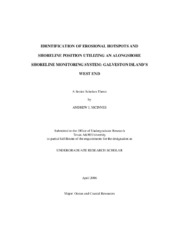| dc.creator | McInnes, Andrew J. | |
| dc.date.accessioned | 2006-07-11T14:19:34Z | |
| dc.date.available | 2006-07-11T14:19:34Z | |
| dc.date.issued | 2006-07-11 | |
| dc.identifier.uri | https://hdl.handle.net/1969.1/3658 | |
| dc.description.abstract | A continuous synoptic alongshore method of beach surveying was developed to identify shoreline position, erosional hotspots, and to examine the morphological variation of the Gulf beaches of Galveston Island’s west end. Near-weekly (average 3 per month) surveys were conducted over 15 consecutive months for the approximately 30 km section of the west end of Galveston Island beginning April 2004 through September 2005. Erosional or accretional hotspots are operationally defined here as areas which can be statistically determined to have significantly greater migration than the mean migration for the entire beach, and are often, but not necessarily, ephemeral. The shoreline, by definition, is the wetline - the wet/dry interface on the beach, the furthest point of wave run-up - and was recorded by tracing the wetline immediately after the turn of the high tide utilizing an all Terrain Vehicle (ATV) equipped with a post-processed kinematic Global Positioning System (GPS). This system provides high-resolution topographical surveying with sub-decimeter accuracy in the both the horizontal and vertical dimensions. The data were assembled in order to determine mean wetlines – monthly, quarterly, or annually; repeated localized statistically significant landward advance of the shoreline is indicative of potential erosional hotspots while an annual net landward migration of the wetline indicates a retreating shoreline - erosion. This work demonstrates that by using this economically feasible surveying method, highly accurate shoreline positions can be used to monitor the morphological changes of the shoreline and to identify erosional hotspots. Over the study period the area exhibited a mean annual erosion rate of 4.95m -1 with a range of 59.83m (-23.86m to 36.04m); the median offset was 4.73m; and mean elevation of the wetline was 1.15m (elevation lacks uniformity both spatially or temporally). This project shows that frequent synoptic surveys enable the identification of erosional hotspots and enables the establishing of an accurate, non-datum corrected shoreline position. Regular monitoring enables determination of erosional hotspots and shoreline migration due to storm events and annual cycles. Archiving and analysis of these short-term vacillations provides a long time-series of shoreline position and is of utility to coastal management and numerous stakeholders. | en |
| dc.description.sponsorship | Texas Institute of Oceanography, TAMUG Coastal Geology Laboratory | en |
| dc.format.extent | 3018346 bytes | en |
| dc.format.medium | electronic | en |
| dc.format.mimetype | application/pdf | |
| dc.language.iso | | |
| dc.subject | Erosion, hotspots, beach monitoring, shoreline, Galveston Island, Kinematic GPS | en |
| dc.title | IDENTIFICATION OF EROSIONAL HOTSPOTS AND SHORELINE POSITION UTILIZING AN ALONGSHORE SHORELINE MONITORING SYSTEM: GALVESTON ISLAND’S WEST END | en |
| dc.type.genre | Thesis | en |
| dc.type.material | text | en |
| dc.format.digitalOrigin | born digital | en |


